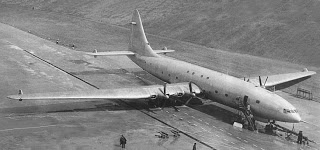A flight into nostalgia…

Do you remember the Brabazon? It was the wonder of the age when it first appeared, but unfortunately it came too late, due to a little event known as the ‘Second World War’!
For those of you who are too young to remember, or not interested in the secrets of flight, the Brabazon was an aeroplane. That’s all, just an aeroplane, but what an aeroplane!
 It was first conceived and designed, (originally as a heavy bomber), in the late thirties, when the largest passenger carrying aircraft were Saunders Roe seaplanes, which would carry about thirty passengers and could get from England to Australia in something like a fortnight. The British Royal Air Force was mainly equipped with Bristol Bulldogs, Tiger-moths and various other twin-winged aircraft. It was all fairly primitive in those days!
It was first conceived and designed, (originally as a heavy bomber), in the late thirties, when the largest passenger carrying aircraft were Saunders Roe seaplanes, which would carry about thirty passengers and could get from England to Australia in something like a fortnight. The British Royal Air Force was mainly equipped with Bristol Bulldogs, Tiger-moths and various other twin-winged aircraft. It was all fairly primitive in those days!
No one really knew anything about the Brabazon when it was originally started, it was a tightly guarded secret that was intended to be exploded onto the public once all the problems had been ironed out and the prototype had been built. By the standards of the thirties it was a colossal venture, in all ways, costing hundreds of thousands to design and build, though no doubt those costs would seem paltry in today’s world.
By 1942 the Air Ministry a had changed their minds about what they wanted and went instead for the highly successful Lancaster bomber, leaving the Bristol Aeroplane Company, (BAC), with a half completed design and no idea what to do with it. However, by 1943 a Government committee, looking towards the end of the war decided a new aircraft for the civil aviation market, and so the Brabazon came into being.
The plane was trundled out of it’s hanger and flown, on 4 September 1949. A special, colossal hanger had been built to house it and several villages had to be destroyed to accommodate the 2,440m length of the runway it needed. I had the great good fortune to be there at Filton on the day that Bill Pegg first flew it; I was 14 at the time and friends and I went there for several days, hoping to see the event, which we eventually did.
Brabazon was powered by eight engines, in four nacelles, each with two contra-rotating propellers, had a wing span of 64metres and could carry, if it had gone into service, one hundred passengers. The fuselage was 8 metres in diameter, (nearly 2 metres larger than a 747), and the plane was the first in the world to possess 100% powered flying controls, among other revolutionary equipment now standard on other aircraft. Each passenger would have been allocated a space about equal to that of a small car – luxury indeed!
But it was all too late! The design, which had seemed so revolutionary in 1940 had now been superseded by such as the Boeing 700 series and other pure jet powered planes, all able to carry more passengers, at much cheaper rates and over greater distances, culminating in the Comet, the Boeing 747 and, later on the Concorde.
Nonetheless, although no more Brabazon’s were ever built, that first model flew for several more years as a scientific, flying laboratory until it was eventually broken up for scrap in October 1953. As I said earlier, many of the sophisticated pieces of equipment we now take for granted, were developed in that one Brabazon.
That day, way off in 1949, when Brabazon first flew, was a proud and exciting one for me, another of those events that stick in the memory for ever, like the death of Kennedy, but much more pleasant!








 Proudly Australian owned and operated
Proudly Australian owned and operated